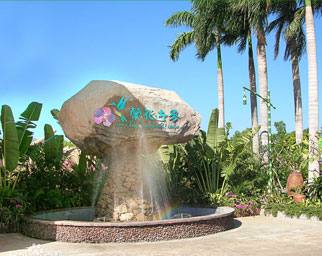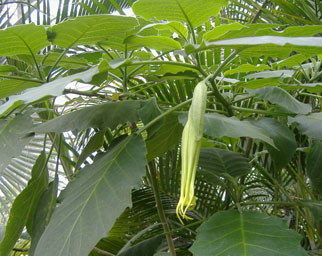
Hainan Tropical Botanical Garden,founded in 1958,is located in Baodao Xincun, Danzhou, Hainan. It belongs to the Tropical Crops Genetic Resources Institute(TCGRI) of Chinese Academy of Tropical Agriculture Sciences(CATAS). It is a comprehensive research institution and scenic spot, integrating scientific research, species preservation and science education. Many awards have been awarded, such as "National Youth Science and Technology Education Base", "National Science Education Base", "Hainan Youth Science and Technology Education Base" and "Hainan Tourism Designated Unit".
In 1950s, in order to develop China’s natural rubber industry, "Liangyuanees" (the South China Academy of Tropical Crops Research Institute and the Southern China Agricultural College Hainan Branch) moved from Nanxiu Village in Shipai, Guangzhou, Guangdong to Baodao Xincun, Danzhou, Hainan. In 1958, they established the Hainan Tropical Botanical Garden under the care of Zhou Enlai and Wang Zhen. After nearly 60 years of development, Hainan Tropical Botanical Garden covers an area of 100 hectares, has 2600 kinds of tropical and subtropical plants from over 40 countries, including over 50 kinds of the national protection of endangered plants, over 750 kinds of tropical flowers and 1000 kinds of medicinal resources.
There are eight core attraction areas in the park: Aquatic Plant Area,Bamboo Area,Medicinal Plant Area,Spice Area,Economic Plant Area,Ornamental Plant Area,Tropical Fruit Area and Palm Area. Visitors can enjoy a variety of exotic plants here: one of the world's most toxic trees --- Antiaris; magic fruit that can change taste --- Synsepalum dulcificm; token for love and friendship --- Adenanthera; the tree near which Lord Buddha was born --- Saraca asoca; “lovers” tree --- Sandalwood and Caesalpinia; tree with hanging shells --- Kigelia africana and Cassia fistula; “rain”trees ---Snmanea;“king” of flowers --- Cananga odorata; “spring” in desert --- Ravenala madagascariensis; energy plant---Sindora maritima and so on.
Nowadays, following the national "The Belt and Road" strategy and CATAS’(TCGRI’s)“strengthening capacity, expanding influence”strategy, Hainan Tropical Botanical Garden, adhering to "going out and bringing in" principle, continues to strengthen domestic and international exchanges and cooperation, and achieved a lot of accomplishments. New varieties, new technologies, and new achievements have benefited 9 provinces in China's tropical area. Meanwhile, in abroad, more than 20 countries have been trained and 8 countries have been assisted. Moreover, it cooperates with many enterprises to develop tropical agriculture overseas, and has carried out long-term cooperative researches with many international organizations.
Hainan Tropical Botanical Garden takes full advantage of "Scientific research, Tourism, Popularization of science and transformation of scientific achievements". And it is committed to making its own contribution to the implementation of the “International Tourist Island of Hainan” strategy by creating a “Kingdom” of China’s tropical plants, a “Place” for science popularization and scientific research, as well as a “Name-card” of tourism in West Hainan.

At present, there are 4680 species of wild vascular plants in Hainan Island, accounting for 15% of the national plant species, of which about 610 species are endemic to the country. 58 species are classified as national protected plants and 42 species are listed as national key protected wild plants There are more than 2,400 species of shrub species, accounting for 28.6% of the country. Among them, 800 are more timber species with high economic value and 438 are listed in national commercial forest. There are about 3,100 kinds of medicinal plants, accounting for 30% of the whole country. As of the end of 2002, Hainan Province, the total forest area of 1.76 million hectares, the forest coverage rate of 53.3% (China's forest average coverage of less than 18%), of which a wide range of plants, highly research value.
Hainan plant species rich, the island has only 4,600 kinds of vascular plants, of which more than 600 kinds of plants for Hainan unique; this does not include a wide variety of ferns, moss and algae and other green plants. The diversity of plants in Hainan is second only to Yunnan, and one of the six hotspots of the world's biodiversity. Hainan is known as "natural medicine library," said. Among these green plants, there are more than 2,500 kinds of medicinal plants closely related to human health, and there are more than 500 kinds of medicinal plants, among which 13 species are anti-cancer plants.

Pterdophyta: 1.Lygodiaceae Lygodium sp. 2.Thelypteridaceae Cyclosorus gongylodes (Schkuhr.) Link C. parasiticus (Linn.) Farwell 3.Aspleniaceae Neottopteris nidus (L.)J.Sm 4.Azollaceae Azolla imbricata(Roxb. )Nakai
Gymnospermae: 1.Cycadaceae Cycas hainanensis C. J. Chen C. rumphii Miq. Zamia furfuracea L. 2.Araucariaceae Araucaria cunninghamia Sweet 3.Cupressaceae Sabina chinensis (L.) Antolne cv. Kaizuca Cheng S. chinensis (L.) Ant Chamaceyparis pisifera (S.et.Z.) Endl 4.Podocarpaceae Podocarpus nagi (Thunb.) Zoll et Mor. ex. Zoll
Dicotyledoneae: 1.Magnoliaceae Michelia champaca L M. alba DC 2.Annonaceae Annona muricata L A. squamosa L Artabotrys hexapetalus (L.f.) Bhandari 3.Lauraceae Cinnamomum camphora (L.) Presl C. burmannii (Nees.) Bl C . Cassia Presl.
Telephone:0898-23300209
E-mail:hnrdzwy@163.com
Address:Danzhou treasure island new village